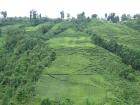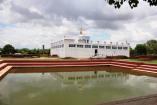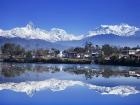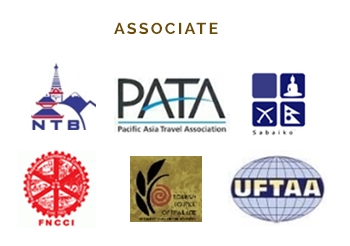KATHMANDU DURBAR SQUARE
Durbar square is one of the most beautiful place in Kathmandu Nepal, it is the generic name used to describe plazas and areas opposite the old royal palaces in Nepal. It consists of temples, idols, open courts, water fountains and more. Before the Unification of Nepal, Nepal consisted of small kingdoms, and Durbar Squares are most prominent remnants of those old kingdoms in Nepal. In particular, three Durbar Squares in the Kathmandu Valley, belonging to the three Newar kingdoms situated there before unification, are most famous: Kathmandu Durbar Square, Patan Durbar Square, and Bhaktapur Durbar Square. All three are UNESCO World Heritage Sites. Several buildings in the Square collapsed due to a major earthquake on 25 April 2015. Durbar Square was surrounded with spectacular architecture and vividly showcases the skills of the Newar artists and craftsmen over several centuries. The Royal Palace was originally at Dattaraya square and was later moved to the Durbar square.
Kathmandu Durbar Square also known as Hanuman Dhoka square is one of the major attractions in Kathmandu Valley. Most of the cultural centers of Nepal are concentrated around the Kathmandu valley; among those cultural sites, the important one is the Hanuman-dhoka Durbar Square. The name Hanuman-dhoka Durbar came from the statue of Hanuman established by the King Pratap Malla at the entrance of the royal palace in 1672 A.D. storeyed residence built by King Prithvi Narayan shah in 1770,is called Basantapur Durbar(palace). The whole complex is also known as Kathmandu Durbar Square. Located at the heart of ancient city in Kathmandu it is srounding both Hindu and Buddhist temple. Most of them are built in the pagoda style embellished with intricately carved exteriors as well as Most of the buildings we see here date from 15th to 18th century . The Durbar Square, with its old temples, palaces, epitomizes the religious and cultural life of the people. The major Interesting things to see here are "Kumari (The Living Goddess) Gar" "Kastha Mandap"Maru Ganesh, Mahadev Temple, Shiva Parvati Temple, Bhagwati Temple, Old palace, Saraswoti temple, Krishna Octangular Temple, Big drums, Kal Bhairav, Jagannath Temple, and Taleju Temple etc..
The Durbar Square are is actually made up of two sub-areas. The outer complex is renowned for numerous interesting temples as Kumari Ghar , Kasthamandap , Shiv-Parbati Temple, Jagannath Temple, Big Bell etc ,while the inner complex comprises the old palace area ,Hanuman-dhoka and its
courtyards as Nasal Choke ,Mul Choke ,Sundari Choke, Basantapur Durbar and other. Besides the magnificent temples and shrines, it has other interesting aspects are various festivals , cultural activities and traditions people are following from centuries, which are presented in the Durbar Square. The major festivals include Indrajatra, Dashain, Gaaijatra, Machchhindra-nath jatra ets. These are the occasion when the people from all over the city gather here to mark their centuries old traditions. All the carving and architecture in this area are exceptionally fine which make the architecture in this Hanuman-dhoka Durbar square among the most important sights for travelers to see.
Taleju Temple:- The Temple built in 1562 AD by King Mahendra Malla, was dedicated to the royal deity of the Malla Kings. The temple is 36.6 meters high. The temple is opened once in a year for publice at the occassion of Dashain festival.
Jagnath Temple:- The Temple of erotic carvings & immage of Jagnath was installed in 1563 AD during the reign of Mahendra Malla.
Krishna Temple:- The temple was built in 1649 AD by King Pratap Malla in memory of his dead queens. The statu of the King and Queens representing as Lord Krishna and his consorts.
Stone column:- The stone column represents the statue of King Pratap Malla in Praying gesture to Goddess Taleju.
Degutalle Temple:- The Temple was built in 1671 AD by King Shiva singh and renovated by King Pratap Malla , representing a tantric Goddess and the family deity of the Mall Kings is restricted to visitorrs.
Shiva – Parvati Temple:- The temple was built during the reign of King Rana Bahadur Shah.
Hanuman statue:- The Hanuman pedestal was erected by the King Pratap Malla in 1672 AD.
Big Bell:- The bell erected in 1997 AD by King Rana Bahadur Shah.
Kal Bhairav:- Bhairv – Lord Shiva’s ferocious from was erected by King Pratap Malla. This is the one of the largest image of Bhairav.
Maju Dewal:- The Temple was built in the late 17th century by Queen Mother Riddhi Laxmi and dedicated to Lord Shiva.
Trilokya Mohan narayan:- This Vishnu Temple was built late 17th century by King prithibendra in memory of his deceased brother near ‘Kumari Ghar’.
Basantapur Durbar:- This Durbar was built in 1770 AD by King Prithvi Nrayan Shah also known as Nau – Talle durbar.
Kumari Ghar:- The temple was built in 1757 AD by King Jaya Prakash Malla, known as Kumari Ghar (the house of living goddess ‘Kumari’) is believed to be the incarnation of goddess Talaju, the protective deity.
Gaddi Baithak:- This Building was built in 1908 AD by Chandra Samser during the reign of King Prithvi Bir Bikram Shah.
Kasthamandap:- This wooden building is said to be constructed from the wood of single tree in 12th century. Kathmandu obtain its name from this historical wooden building ‘KasthaMandap’.
Ashok Vinayak:- This temple is one of the most important shrine in the valley dedicated to the Elephant God Ganesha.
Dhansa:- The temple was built by King Pratap Malla in 1673 AD to start a new masked dance of Narshimha, an incarnation of lord Vishnu.
- Get in touch
Get In Touch
India:
Red Planet Tours & Travels
Elite Plaza (opp. Vishal Cinema)
2nd Mile, Sevoke Road
Siligur - 734001
Phone: +91 9933132575(IND)
Nepal: Kathmandu
Red Planet Tours & Travels
Near Hotel Yak & Yeti Road,
Yak & Yeti Lane
Durbar Marg, Kathmandu, Nepal
Phone: +977 1 5330683/+977 9852662216
Nepal: Kakarbhitta/Kakarvitta
Red Planet Tours & Travels
Main Road, Mechinagar Nagarpalika - 06
Post: Kakarvitta, Jhapa, Nepal
Phone: +977 9842633669





















